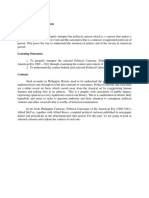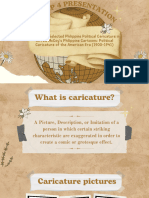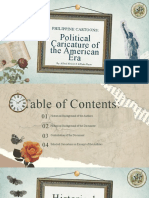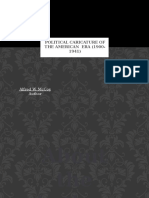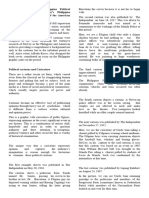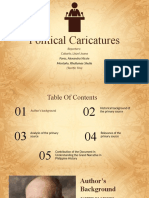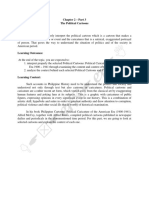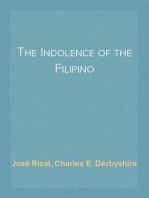0 ratings0% found this document useful (0 votes)
206 viewsPolitical Caricature of The American Era
The political caricatures from 1900-1941 in the Philippines provided commentary on social and political issues during the American era. Key themes included anti-American sentiment and condemnation of the ruling class. Several caricatures highlighted issues like political dynasties and abuse of power. By exaggerating human features and using symbolism, these caricatures reflected public opinion and helped expose issues like corruption and inequality under American colonial rule.
Uploaded by
Clare De Jesus GarciaCopyright
© © All Rights Reserved
Available Formats
Download as DOCX, PDF, TXT or read online on Scribd
0 ratings0% found this document useful (0 votes)
206 viewsPolitical Caricature of The American Era
The political caricatures from 1900-1941 in the Philippines provided commentary on social and political issues during the American era. Key themes included anti-American sentiment and condemnation of the ruling class. Several caricatures highlighted issues like political dynasties and abuse of power. By exaggerating human features and using symbolism, these caricatures reflected public opinion and helped expose issues like corruption and inequality under American colonial rule.
Uploaded by
Clare De Jesus GarciaCopyright
© © All Rights Reserved
Available Formats
Download as DOCX, PDF, TXT or read online on Scribd
You are on page 1/ 3
POLITICAL CARICATURE OF THE AMERICAN ERA
Alfred McCoy Art exaggerating human features and
poking fun at its subject
Born in 1945 Art technique became part of the
Massachusetts, USA print media as a form of Social and
Professor of South East Asian Political commentary, usually targets
History at University of Wisconsin persons at power and authority
at Madison Became effective tool of publicizing
Director of SEA Studies at the opinions through heavy use of
same school SYMBOLISM
History and Politics are the focus of Represents opinion and captures the
his writings audience’s imagination
- Philippine Cartoons (1985) Nationalism, Patriotism, Eye-opener
- Anarchy of Families (1994) and Discover our roots
- Closer than Brothers: Manhood - Commentaries with the
at the Philippine Military caricatures are useful in seeking
Academy (2000) to see the opinions and views of
- Lives at the Margin (2001) people on policies which are
After Ph.D at Yale he focused of 2 rooted on the opinions and
topics views of officials in the
- Philippine Political History government
- Global Opium Trafficking - Becomes the representation of
Document the current conditions of our
country
1900 – 1941 Philippine Political - Lets us see the problem
Cartoons gained full expression - Glimpse of the past
during the American Era Reflected two cartoon themes:
- Filipino artist recorded National - Anti American Sentiments
attributes toward the coming of - Condemnation of the Ruling
the Americans as well as the Class
changing more at times
377 – cartoons compiled 1st Cartoon
- Research based on Philippine Published in “The Independent” on
and American archives May 20, 1916
- Focuses not only on cartoons A politician in Tondo named Dr.
but also on the turbulent period Santos was passing a “crown” down
Achievements to his brother-in-law named Dr.
- 1st book about Caricatures Barcelona
- 1st one to legitimize cartoons as A Filipino guy trying to stop Dr.
sources of Filipino thoughts and Santos – “The crown was not his to
views begin with”
Caricature “A PUBLIC POST IS NOT A
HERIDATARY CROWN”
Art form Here, we can see the use of
symbolism. The crown which stand old and conservative mindset of the
for authority, power or the public Filipinos to the liberal exposure of
post while the Salakot and Barong youngsters.
Tagalog shows that the guy wearing
it is a Filipino. 5th cartoon
Depicts the abuse of power and the Who is Uncle Sam?
current situation during that time. - "Uncle Sam", "Big
Today, we can relate political Brother","Yankee Daddy", they are
dynasty to this caricature all symbols of government.
In which Uncle Sam is a common
2nd Cartoon
personification of the US Federal
Drawn by Fernando Amorsolo on government or the country itself.
June 16, 1917 Also his name derived from two
Filipino child who stole skinny abbreviation letter of the United
chicken because he had nothing to States, which is U.S (Uncle Sam)
eat The 5th cartoon shows that Uncle
A Police officer relentlessly chasing Sam is riding a chariot pulled by
the child Filipino students. Uncle Sam there,
Juan de la Cruz was grabbing the is a American teacher who taught
officer telling him to leave the child those Filipino students the American
who was a small time pickpocketer culture that is why they are wearing
and eye the great thieves instead such thing such holding a baseball
Commentary to the workings of bat and caps, an armour shield, and
the Manila Police who focuses on etc.
the small time pickpocketer and
lets the thieves committing greater 6th Cartoon
crimes free. Nacionalista Party - is the oldest
Used symbolism to present Juan de political party here in the Philippines
la Cruz who was wearing Salakot and some other parts here in Asia. In
and Barong Tagalog which, Nacionalista Party considered
as a country's vehicle for
3rd Cartoon
independence through the building of
Published in Philippine Free Press a modern nation-state and the
Commentary on the unprecedented advocacy of efficient self-rule free
cases of colorum automobiles in the from the control of the Americans.
city streets *Federalista Party - is a political
Published during the fatal accidents party that advocated the annexation
involving colorum vehicles and taxis of the Federal goverment of America
occurring too often. to the Philippines as a US state.
Wherein, the Americans let Filipinos
4th cartoon rule some government position
American is on the verge of through requiring selected people
introducing their culture to us. from the Elite Cluster of the society
Wherein they drastically introduced in the Philippines.
different modernity, and it includes - Americans also promoted
the drastic shifting of ideology; the Tutelary Democracy, wherin, the
Americans give the power to the •Prolonging of poverty and
Filipinos in terns of governing but underdevelopment
not totally, Filipinos governed under •Continuing prevalence of massive
the American's supervision. corruption
The 6th cartoon shows that, Uncle •Propagation of political and socio-
Sam is doling out the meager economic inequality
patronage to the Filipino government
officials, especially to the members
of Federalista party, with their Relevance and Contribution of Political
victory in the July 1907 election, Caricature
while the Nacionalista members are
still waiting for their turn.
As a valid historical instrument
Analysis
Useful in seeking to see the opinions
Americans promoted different and views of people on politics
strands of changes and shifts in which arr rooted on tbe opinions and
culture, society and mostly to the views of officials in the government
politics. Primers for engaging in the
prevailing opinions of that time
-One of the positive effect of
✓ The selected cartoons illustrate not political cartooon and caricature is
only the opinion of certain media that, it becomes the representationof
about the Philippine society but also the current conditions of our country-
paint a broad image of society and it let us see rhe problems.
politics under the US colonial time.
- In the arena of Politics, we see
that democracy was introduced but
not necessarily practice and it
obviously seen through the rising of
political dynasty.
Political Dynasty - a sequence of
powerful leaders in the same family
tree. There are two classifications of
political dynasty here in the
Philippines, this are:
1. Thin Political Dynasty - which
means that a political clan that only
has two family member swapping in
a certain position in the government
2. Fat Political Dynasty - which
monopolizing power in a
undesireable situation, that every
member of the same family occupies
different positions in the government
at the same time.
Effect of having a Political Dynasty
You might also like
- The Political Caricature During The American Era80% (15)The Political Caricature During The American Era18 pages
- Philippine Caricature - Readings in Philippine History78% (40)Philippine Caricature - Readings in Philippine History17 pages
- Luzon at War: Contradictions in Philippine Society, 1898-1902From EverandLuzon at War: Contradictions in Philippine Society, 1898-19024.5/5 (3)
- Module 2 Lesson 4 Philippine-CaricatureNo ratings yetModule 2 Lesson 4 Philippine-Caricature18 pages
- III. Content and Contextual Analysis (Philippine Political Caricatures)No ratings yetIII. Content and Contextual Analysis (Philippine Political Caricatures)24 pages
- Lesson 6 A Glance at Selected Philippine Political Caricature in Alfred McCoy's Philippine Cartoons100% (1)Lesson 6 A Glance at Selected Philippine Political Caricature in Alfred McCoy's Philippine Cartoons16 pages
- PDF Political Caricature RIPH ABJourn 1A 1BNo ratings yetPDF Political Caricature RIPH ABJourn 1A 1B26 pages
- A Glance at Selected Philippine Political Caricature in Alfred McCoy's Philippine Cartoons Political Caricature of The American Era (1900-1941)No ratings yetA Glance at Selected Philippine Political Caricature in Alfred McCoy's Philippine Cartoons Political Caricature of The American Era (1900-1941)36 pages
- Mccoy Alfred Alfredo Roces Philippine Cartoons - Political Caricature of The American EraNo ratings yetMccoy Alfred Alfredo Roces Philippine Cartoons - Political Caricature of The American Era3 pages
- Philippine Cartoons: Political Caricature of The American Era (1900-1941)No ratings yetPhilippine Cartoons: Political Caricature of The American Era (1900-1941)22 pages
- A Glance at Selected Philippine Political Caricature 1No ratings yetA Glance at Selected Philippine Political Caricature 18 pages
- Alfred Mccoy'S Philippine Cartoons: Political Caricature of The American Era (1900-1941)100% (2)Alfred Mccoy'S Philippine Cartoons: Political Caricature of The American Era (1900-1941)15 pages
- A Glance at Selected Philippine Political Caricature in Alfred Mccoy'S Philippine Cartoons: Political Caricature of The American Era (1900-1941)No ratings yetA Glance at Selected Philippine Political Caricature in Alfred Mccoy'S Philippine Cartoons: Political Caricature of The American Era (1900-1941)18 pages
- Selected Philippine Political Caricature On Alfred McCoy's Philippine84% (44)Selected Philippine Political Caricature On Alfred McCoy's Philippine26 pages
- Political Caricatures of The American EraNo ratings yetPolitical Caricatures of The American Era24 pages
- Philippine Cartoons and Caricatures. HandoutNo ratings yetPhilippine Cartoons and Caricatures. Handout10 pages
- A Glance at Selected Philippine Political Caricatures100% (1)A Glance at Selected Philippine Political Caricatures19 pages
- A Glance at Selected Philippine Political Caricature in Alfred Mccoy's Philippine Cartoons: Political Caricature of The American Era (1900-1941)No ratings yetA Glance at Selected Philippine Political Caricature in Alfred Mccoy's Philippine Cartoons: Political Caricature of The American Era (1900-1941)13 pages
- Political Caricatures of The American Era 1900 1941No ratings yetPolitical Caricatures of The American Era 1900 194118 pages
- This Study Resource Was: Political Caricature of The American EraNo ratings yetThis Study Resource Was: Political Caricature of The American Era4 pages
- Political Caricatures of The American Era (1900-1940s)50% (2)Political Caricatures of The American Era (1900-1940s)22 pages
- Analysis of The Political Caricature During The American PeriodNo ratings yetAnalysis of The Political Caricature During The American Period3 pages
- Analysis of The Political Caricature During The American Period67% (3)Analysis of The Political Caricature During The American Period3 pages
- A Nerd's Response to Neo-Fascist Appropriation of Sci-Fi and Fantasy Works for the Purpose of "Triggering Liberals"From EverandA Nerd's Response to Neo-Fascist Appropriation of Sci-Fi and Fantasy Works for the Purpose of "Triggering Liberals"No ratings yet
- Vietnam Special Report - Journey To The East - The Expansion of HCMC Metropolis - Part 1 - SEP 2020No ratings yetVietnam Special Report - Journey To The East - The Expansion of HCMC Metropolis - Part 1 - SEP 202032 pages
- Four Wonderful Opportunities: 1. The Encounter Opportunity100% (2)Four Wonderful Opportunities: 1. The Encounter Opportunity2 pages
- MAS-AMiCUS ICD Newsletter Vol 1 Issue 1 - 1st EdNo ratings yetMAS-AMiCUS ICD Newsletter Vol 1 Issue 1 - 1st Ed4 pages
- People V Villacorta, GR 186412 September 7, 2011No ratings yetPeople V Villacorta, GR 186412 September 7, 201115 pages
- Criminal Law 1 Second Term Exam Without AnswerNo ratings yetCriminal Law 1 Second Term Exam Without Answer9 pages
- RESOLUTION NO. 2024-02 - KK Constitution of By LawsNo ratings yetRESOLUTION NO. 2024-02 - KK Constitution of By Laws7 pages
- Upsssc Pet Shift 2 Answer Key Official 91No ratings yetUpsssc Pet Shift 2 Answer Key Official 9116 pages
- A Teacher Christmas Worksheets SchoolagersNo ratings yetA Teacher Christmas Worksheets Schoolagers8 pages
- B43. Magnesium Sulphate Powerpoint PresentationNo ratings yetB43. Magnesium Sulphate Powerpoint Presentation21 pages
- The External Dimension of the EU s Migration Policy Different Legal Positions of Third Country Nationals in the EU a Comparative Perspective 1st Edition Katharina Eisele download pdf100% (5)The External Dimension of the EU s Migration Policy Different Legal Positions of Third Country Nationals in the EU a Comparative Perspective 1st Edition Katharina Eisele download pdf71 pages
- Rush Application Locations: Province Post Office AddressNo ratings yetRush Application Locations: Province Post Office Address3 pages
- The Linguistic Reorganisation of States in India in The 1950sNo ratings yetThe Linguistic Reorganisation of States in India in The 1950s6 pages
- Encyclopedia of Modern China Vol 4 Part 2No ratings yetEncyclopedia of Modern China Vol 4 Part 2338 pages



